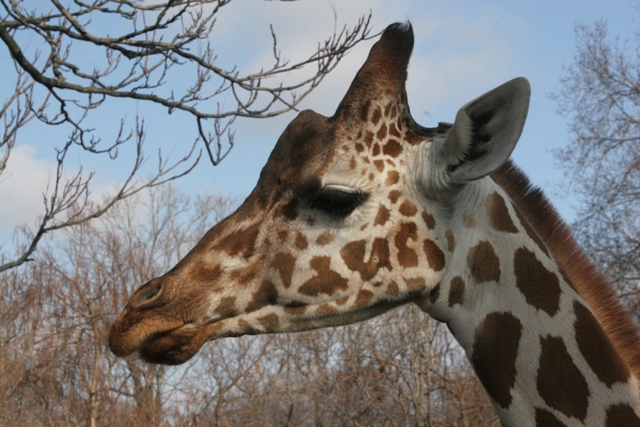| 댓글 |
|
| | 손님 |
|
 |
Reticulated Giraffe
Giraffa camelopardalis reticulata
The giraffe is the tallest animal in the world. Males reach a towering 19 feet tall and weigh between 2400 and 4250 pounds. Females measure up to 17 feet tall and weigh between 1540 and 2600 pounds. A lot of this height and weight is because of the giraffe??? incredibly long neck, which can be 8 feet in length and can weigh almost 500 pounds. Even though the giraffe??? neck is taller than most humans are, it is still made of only 7 bones. This is the same number of bones that are in the human neck. On the top of their heads, giraffes have horns made of solid bone and covered with skin. These are used for sparring between males. The giraffe is also known for its spots. In fact, the Romans called the giraffe "camelopardalis," meaning "camel marked like a leopard." These spots are unique to each giraffe, much like fingerprints are unique to each human. In fact, people who study many giraffes can distinguish between the different giraffes just by looking at their spots. Another unique feature of the giraffe is its unusually long tongue. This pink and black tongue can be 22 inches long and is used to grab food from the trees.
The giraffe feeds mainly on Acacia and Combretum trees, but will eat as many as 100 different plants depending on which are available at the time. Since giraffes have such long necks, they can reach a 6-foot band of foliage that is above the reach of all other animals except the elephant. The giraffe will use its upper lip and long tongue to strip the leaves, shoots, flowers and vines from the trees. It needs 75 pounds per day of vegetation. However, it only drinks water every 2 to 3 days when it is available and can go for weeks without drinking any. The giraffe gets a large amount of water from the dew on the leaves and from the water in the leaves. When it encounters a watering hole, it will drink up to 12 gallons of water at one time. Giraffes have four stomachs just like cows.
Giraffes are native to only Africa. They used to be found throughout the dry savanna zones south of the Sahara Desert, but today have been eliminated from most of West African and southern Kalahari range. However, they are still fairly common.
Adult giraffes are too big to fall prey to the predators of Africa. However, the young giraffes are hunted by lions, hyena, leopards, and African wild dogs. A mother will stand over her calf to protect against the lions, which run the risk of getting killed by a kick from the mother's powerful legs. Even with this protection, 50 to 75 percent of all calves are killed during the first few months. For the survivors, the life expectancy is 20 to 25 years.
The giraffe herd is not as rigidly structured as that of other animals. At any given time, the herd may consist of all males, all females, a mix of females and young, or a mix of all. Unlike most herds, the giraffe herd of 20 animals has no leader. Because of their large size, it is not necessary for the giraffes to stay in a tight group. In addition, they are tall enough to be able to see each other at long distances. The result is a herd that may be spread out over half a mile. Males spar in daily contests to determine mating rights, using their horns and strong necks to deliver heavy blows to each other. By the time that a female is ready to mate, the dominant male has already beaten all the other males in these contests. Once rank has been determined, the giraffes usually live peacefully alongside each other.
Giraffes breed throughout the year, but most often after the rainy season. After a gestation period of about 14 to 15 months, a 6-foot tall baby giraffe, called a calf, is born. For the first 2 weeks, the mother guards her young, who spends most of the time lying down. If there are a lot of calves in the herd, one female may take care of all of them until they get older.
Giraffes have very keen eyesight, allowing them to keep other members of the herd in sight. They also have good hearing and sense of smell. Giraffes have scent glands that give off a pungent odor. Many believe that the giraffe is mute, but this is only a myth. Though they are normally silent, they can grunt, snort, growl, sneeze, snore, moo, bleat, and cough. |
|
|
